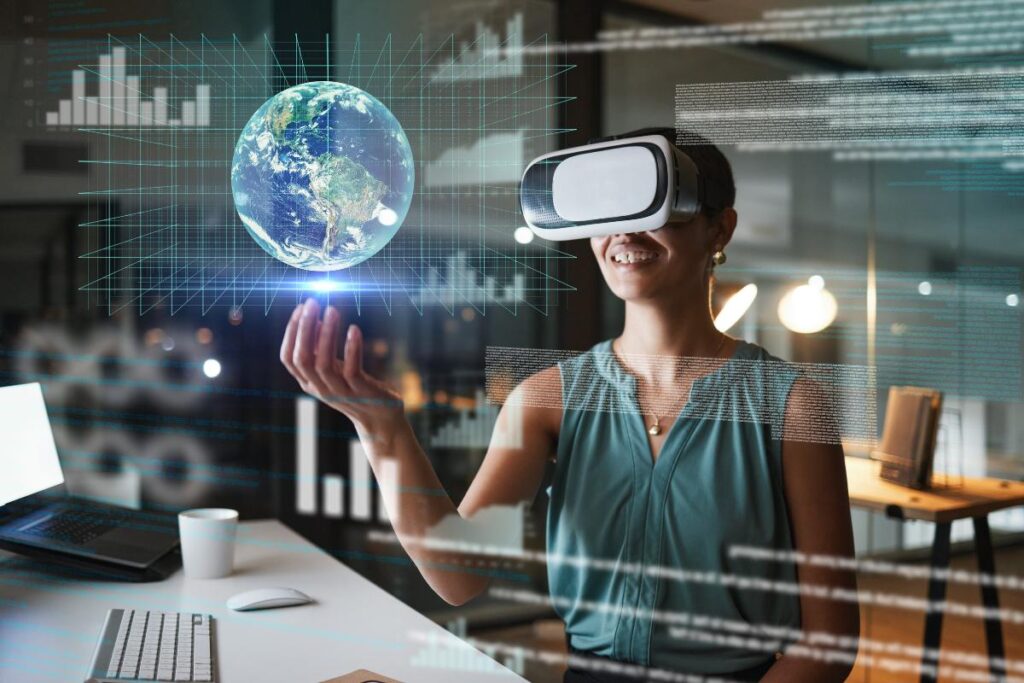
Augmented Reality (AR) is revolutionizing the marketing landscape, offering brands an unprecedented way to engage with their customers. From immersive shopping experiences to interactive advertising, AR is reshaping how consumers perceive and interact with products and services. This cutting-edge technology blends digital elements with real-world environments, creating a unique and engaging user experience. In this article, we explore how AR is transforming marketing, its benefits, successful case studies, and how businesses can leverage this technology to stay ahead in the competitive digital marketplace.
The Power of Augmented Reality in Marketing
The rapid advancement of AR technology has enabled marketers to provide immersive and interactive brand experiences like never before. Unlike traditional marketing methods, AR allows consumers to engage with products virtually, bridging the gap between the physical and digital worlds.
Key areas where AR is making a significant impact in marketing include:
- Immersive shopping experiences
- Interactive advertisements and campaigns
- AR-powered product visualization
- Enhanced customer engagement and brand recall
Immersive Shopping Experiences: Try Before You Buy
One of the most exciting applications of AR in marketing is virtual try-ons. Brands across various industries, from fashion to furniture, are using AR to allow customers to visualize products in real-world settings before making a purchase.
Fashion and Beauty Industry
- Major brands like Sephora and L?Or?al have implemented AR-powered virtual makeup try-ons, enabling customers to see how different products look on their faces.
- Nike and Adidas use AR to let customers try on sneakers digitally, enhancing the online shopping experience.
Furniture and Home Decor
- Companies like IKEA and Wayfair use AR apps that let customers visualize how furniture will look in their homes, reducing uncertainty and increasing purchase confidence.
Interactive Advertising: Engaging Consumers Like Never Before
AR advertising transforms passive viewers into active participants, making marketing campaigns more engaging and memorable. Brands are leveraging AR-powered ads to create unique, interactive experiences that captivate consumers.
AR Filters and Lenses on Social Media
- Platforms like Instagram, Snapchat, and TikTok allow brands to create AR filters and lenses that engage users in an entertaining and interactive way.
- Pepsi?s AR bus stop campaign amazed passersby by displaying interactive 3D visuals of UFOs, robots, and wild animals, making the campaign go viral.
Gamification in Marketing
- AR-based gamification helps brands drive customer engagement and loyalty.
- McDonald?s Monopoly AR campaign enabled customers to scan game pieces and unlock digital rewards, increasing customer participation.
AR-Powered Product Visualization: Boosting Sales and Reducing Returns
Product visualization through AR significantly enhances the customer decision-making process. Customers can see how a product fits their needs without physically interacting with it, reducing hesitation and increasing conversion rates.
E-commerce and Retail
- Amazon and Shopify integrate AR features that enable customers to see 360-degree product views, improving online shopping experiences.
- Warby Parker uses AR for virtual eyewear try-ons, ensuring customers find the perfect fit before ordering.
Automotive Industry
- Porsche and BMW offer AR-powered car configurators, allowing customers to customize and visualize vehicles in real-time before making a purchase.
Enhancing Customer Engagement and Brand Recall
AR marketing creates memorable and engaging experiences, improving brand recall and customer retention. Businesses that adopt AR stand out from competitors and build stronger connections with their audience.
Interactive Storytelling
- Brands can tell compelling stories through AR, making advertisements more engaging.
- The New York Times used AR to enhance news storytelling, allowing readers to interact with 3D visuals.
Live Events and Experiential Marketing
- Companies host AR-powered live events where customers can interact with digital elements in real-time.
- Coca-Cola?s AR campaign in shopping malls allowed visitors to interact with digital polar bears, increasing engagement.
The Future of AR in Marketing
As 5G technology and AI-driven AR solutions continue to evolve, the potential for AR in marketing is limitless. Here?s what the future holds:
- Hyper-personalized AR experiences based on consumer preferences and behavior.
- Integration of AI and AR for enhanced customer interactions.
- More accessible and affordable AR solutions for small businesses.
- Web-based AR experiences eliminating the need for separate apps.
Conclusion: Why Businesses Should Invest in AR Marketing
Augmented Reality is no longer a futuristic concept?it is a powerful marketing tool that is transforming the way brands interact with consumers. Businesses that leverage AR will gain a competitive edge by offering immersive shopping experiences, interactive advertisements, and engaging customer interactions.
Adopting AR in marketing not only enhances brand engagement and customer satisfaction but also boosts sales and reduces product return rates. As technology advances, AR will become an indispensable component of digital marketing strategies.